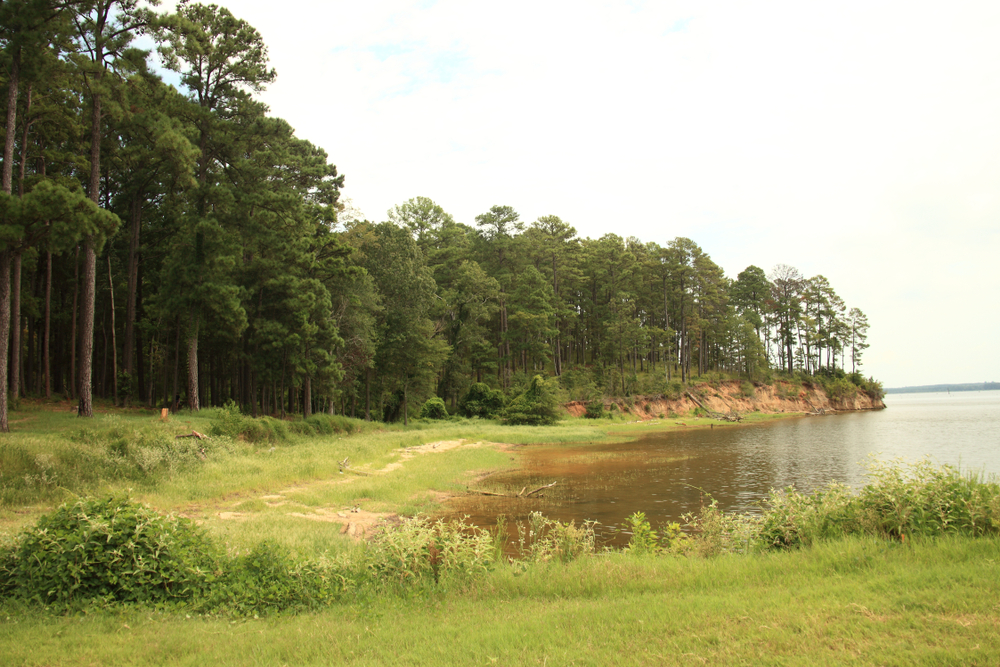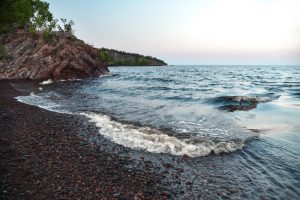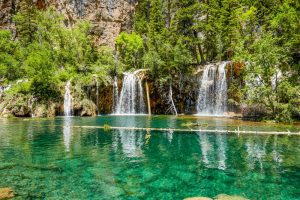Based on a 2012 report from the National Lakes Assessment, of the 111,119 lakes they evaluated, around 52% were natural and the rest were man-made.
The National Lakes Authority (NLA) discovered that natural lakes range in size from small to enormous, but most man-made reservoirs are smaller.
40% of reservoirs are smaller than 10 acres, but only 22% of lakes are the same size, such as in Texas. That brings us to the question, what is the largest lake in Texas?
The Largest Lake in Texas is Toledo Bend, which spans over 100 miles. Situated about 80 miles northeast of Beaumont, Texas on the Sabine River, its dam creates the largest reservoir in Texas, the Toledo Bend Reservoir.
Even though the dam is located at Toledo Bend, the reservoir spans several counties in Texas and two in Louisiana.
It acts both as a recreation area and a hydroelectric power facility.
Table of Contents
What are the areas that Toledo Bend Lake spans?

It spans the counties of Sabine and Newton in Texas, as well as Shelby and Panola in Louisiana.
On May 11, 1964, work began on the Toledo Bend Dam on the Sabine River, near the Texas-Louisiana border, and on October 3, 1966, water began to be deliberately accumulated.
When was the Toledo Bend Dam created?
In 1969, the state built the Toledo Bend Dam. The general contractor was Massman-Johnson Construction Company, and the two states split the project’s costs equally, with no help from the federal government.
The Sabine River authorities in Texas and Louisiana own the Toledo Bend Dam and Reservoir.
With an elevation of 175.3 feet above the average sea level, its maximum planned water surface is located at an elevation of 185 feet above the average sea level.
Eighty-seven thousand and seven hundred and fifty-five kilowatt-hours are generated by two hydroelectric plants incorporated in the dam.
How vast is the Toledo Bend Reservoir?
Water and energy are shared between Texas and Louisiana. The Toledo Bend Reservoir conserves water for municipal, industrial, agricultural, and recreational uses across a region of drainage extending more than 7,000 square miles and extending for more than 100 river miles.

At a conservation pool height of 172 feet above mean sea level, the lake has a 181,600-acre conservation surface area and a pooled storage capacity of nearly 4.5 million acre-feet.
At the top of the emergency spillway gates, the overall capacity of just over 4.6 million acre-feet at a height of 173 feet above the sea’s level.
The Reservoir is the South’s largest man-made lake and the country’s sixth-largest lake by surface area.
By total storage capacity, it is the third-largest reservoir in or shared by Texas.
Is Toledo Bend a man-made lake?
Yes! No other lake comes close in size within Texas. It is also the biggest in Louisiana, which shares a portion of the lake and ranks sixth in the United States by surface area.
Does the Toledo Bend Lake cause flooding?
The Sabine River frequently floods the Orange area, causing extensive damage. Other concerns for this project were those for municipalities, industries, agriculture, and recreation, which led to the establishment of the Sabine River Authority of Texas (SRA-T) in 1949 and the Sabine River Authority, State of Louisiana (SRA-L) in Louisiana in 1950.

How much electricity does Toledo Bend Lake generate?
Ninety-two megawatts of electrical power can be generated by the dam. Newton County, Texas, is home to the dam, although the reservoir extends far beyond its borders, into the parishes of Desoto and Sabine in Louisiana, as well as the counties of Panola, Shelby, and Sabine in Texas.
Texas and Louisiana signed a memorandum of agreement known as the Sabine River Compact in 1953.
The agreement was approved by both states’ legislatures, as well as the United States Congress and the president at the time.
After World War II, the Sabine River Watershed Association in Texas and citizens from Louisiana worked together to establish a supply of freshwater that comprised hydroelectric energy as well as recreation.
This resulted in the formation of these organizations and the compact.
Is Toledo Bend Lake federally funded?
In 1955, a feasibility study was started, and by 1959, the two states had agreed to contribute $30 million to the project.
The site was purchased in 1963, and construction began in 1964. At the time of completion in 1969, Texas was estimated to have contributed $70 million to the project, which was overseen by Massman-Johnson Construction Company.
Neither the federal government nor any other state contributed to the construction of the dam.

Lacking federal funding, Louisiana Director of Public Works Claude Kirkpatrick, who was also president of the Sabine River Authority of Louisiana at the time, advocated for a cooperative agreement with Texas to make the project happen.
Freshman Representative Cliff Ammons of Many, the seat of Sabine Parish, successfully pushed the Toledo Bend legislative measure despite various difficulties.
Funding for the reservoir project came from Constitutional Amendment 8, which tapped monies from Civil War pensions.
Despite Ammons’ reputation as “the father of Toledo Bend,” he was defeated in the 1964 elections for the state legislature.
The river authorities of Louisiana and Texas began purchasing land for the state’s largest reservoir in May 1963 as part of a collaborative management initiative.
On May 11, 1964, construction began on the Toledo Bend energy plant, spillway, and Dam, spillway.
In October 1966, the earthen embankment was completed, and the water was pumped into the dam.
The power plant was completed and put into service in the first half of 1969. Hydroelectric power generation and recreation were the primary reasons for constructing the Toledo Bend Project.
What types of recreational activities are available at Toledo Bend?

Recreational opportunities are nearly limitless in Toledo Bend, which boasts some 1,200 miles of shoreline and is a major factor in meeting the expanding demand for water-oriented outdoor activities.
Recreational activities such as swimming and boating are accessible at a variety of private and public facilities.
Several clubs hold tournaments in the reservoir, which is a popular spot for freshwater fishing.
Due to the enormous quantity of trees and stumps still in the lake, shallow-draft powerboats are the best option at this time.
On the boat lanes, one should use caution, but one should be especially careful of the boat lanes and keep an eye out for floating logs, stumps, and trees, even if the lanes are well marked.
When is the best time for fishing at Toledo Bend?
Summer is the best time to fish in Toledo Bend Lake. Among Texas freshwater anglers, largemouth bass is the most sought-after recreational species but catfish are also popular.
Eighty percent of all anglers in Texas target catfish at some point during their excursions, according to surveys performed by TPWD biologists and game wardens.
Catching catfish is more likely to be successful in May and June. Bullheads, Flatheads, Blues, and Channel catfish, are the most common kind of catfish found in the Texas Lakes.
Catfish can weigh anything from a few pounds to more than 100 pounds, depending on the species.
What are the best baits for catfishing at Toledo Bend?

Live baits:
- Hellgrammites,
- Live minnows,
- Catalpa worms,
- Nightcrawlers
- Earthworms
Dead baits: the more odiferous, the better
- Dead shrimp,
- Shad gizzard chunks
Other fresh dead baits work well as stink baits, whether they’re bought or manufactured at home. Smelly foods like cheese and hot dogs tend to be the most popular.
Sliding floats or cork rigging, or an oval-shaped sliding sinker, are the most common ways of fishing in this area.
How do you catch a monster fish in Toledo Bend Lake?
If you want to catch a monster fish, look for deep water and submerged river systems. Whether fishing with a rod and reel, trotlines, or jug lines, the most common bait is a live sunfish, which can be 3 to 5 inches long.
When it comes to blue catfish, the Lake Texoma record weighs in at 121.5 pounds. Lake Palestine holds the rod and reel flathead record with a weight of 98.5 pounds.
Livingston’s Lake Livingston produced the largest flathead ever captured by trot lining – 114 pounds.
Lake Conroe, Lake Lewisville, Richland Chambers, Choke Canyon, Toledo Bend, and Wright-Patman are some of the best places to catch catfish in regard to bulkhead fishing.

Is Toledo Bend Lake a safe place to swim?
Swimming in Toledo Bend Lake is a wonderful experience! And what better way to close out the summer than with a family swimming trip?
The lake’s position is ideal for water sports, boating, fishing, swimming, and more, making it a wonderful area to spend time with family and friends.
Does Toledo Bend Lake have a variety of swimming spots?
Visitors to Toledo Bend Lake have a variety of swimming spots to choose from while there.
Some of the options available to individuals who enjoy the lake’s waters include swimming from the shore or a boat.
Many other options can be found in the following section.
Are there any designated swimming areas in Cypress Bend Park?
Yes! On Toledo Bend Lake, Cypress Bend Park is a relatively new swimming spot. On a warm day, the beach is one of the best places to take advantage of the water’s natural beauty.
Cypress Bend Park also offers fishing, picnicking, pavilions, cabins, RV camping, and a variety of other activities.

Is there a swimming area at Toledo Bend State Park?
North Toledo Bend State Park and South Toledo Bend State Park are both located on the Louisiana side of the lake, and both provide access to swimming.
Each venue charges a $3 entry fee per guest. Each location offers a variety of additional activities for the whole family to enjoy, such as boating, fishing, park visits, and more.
Does Pleasure Point Park have a Swimming Zone?
Visitors to Pleasure Point Park can relax on the park’s white sand beach. There are also boat ramp areas, fishing piers, and campsites for RVs in the park.
The park is located in Florien, Louisiana, and admission is $2 per person.
On the Texas side of Toledo Bend Lake, are there any swimming spots?
At the Texas end of Toledo Bend Lake, you’ll find plenty of opportunities to cool off in the water.
Going for a swim close to Cliffside Lodge & Cabins, Fin & Feather Resort, and Harborlight Marina & Resort are just a few of the options available to you.
Are you allowed to swim in Toledo Bend Lake’s Coves?

Coves can be found on both the Texas and Louisiana sides of Toledo Bend Lake. Taking a swim within the coves provides partially private spots for a refreshing dip.
Check the lake and the weather before deciding to go for a swim to make sure that the conditions are safe for you and your family.
In regard to swimming, things can change regularly. The importance of protecting yourself and your loved ones cannot be overstated.

















